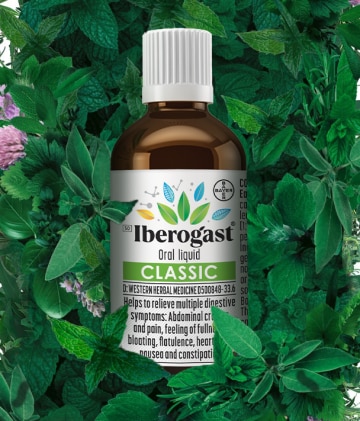Caraway fruit (Carvi fructis) – much more than a culinary herb
One of the main remedies against heavy digestion is caraway, a medicinal plant of the same family as fennel. Caraway is often the spice of choice in the preparation of many dishes such as fried potatoes, sauerkraut or even bread. But it is not only the taste that makes caraway so special - its slightly relaxing effect transforms difficult-to-digest, flatulent or high-fat meals into well digestible ones.
As an ingredient of Iberogast®, caraway fruits contribute to its tonicizing effects on the gastrointestinal tract.
Also known as Persian cumin, caraway is native to the Middle East, Europe and North Africa. The origins of the name are highly disputed, as both the Greek (karon) and the Sanskrit (karavi) descriptors have also been used as names for other plants (cumin and fennel).
The effect of caraway fruits on the gastrointestinal tract
Caraway fruits have several benefits: They not only have an antispasmodic effect, but also help with flatulence and fullness.
Caraway has been officially recognized by the European Scientific Cooperative on Phytotherapy (“ESCOP”) as an agent for resolving stomach complaints and flatulence in children often suffering from colics.
The valuable ingredients of the caraway stimulate digestion. Due to its germicidal effect, caraway can also counteract inflammation in the gastrointestinal tract. in Iberogast® the extracts of caraway fruits contribute to its anti-inflammatory and mucosa protective effect.
At a glance: this is how caraway fruits in Iberogast® affect digestion
The following table shows the different active contributions of caraway fruits in Iberogast®:
| Active benefits of caraway fruits in the frame of irritable stomach | |
| Activation of the musculature in the lower stomach | |
| Relaxation of the musculature in the upper stomach | |
| Anti-inflammatory | |
| Regulation of acid production | |
| Protection of the mucosa |
Legend:
| Light Impact | Medium Impact |
High Impact |

First known uses of caraway seeds
It is important to know that the caraway seeds are not seeds at all. The fruits of the caraway plant grow as achenes – dried, simple fruits, containing only one seed each. The first know use of caraway dates back to 3000 B.C., as there have been dried fruits found in the foundations of houses dated to that period. The first written testimony dates to around 200 A.D. in the old Roman recipe collection De re coquinaria (On the subject of cooking), also known as the Apicus.
- the Bayer Vital GmbH grows bitter candytuft in large cultures around the company headquarters in Darmstadt? And it has been doing that for over 50 years.
- the wild-breeding medicinal plant is threatened with extinction in Germany? Isolated patches occur only on fields and in vineyards in the southwest.
- the iberis amara flowers smell sweet, but taste bitter?
- the bitter candytuft flowers bloom annually from May to August?
Interesting facts about caraway fruits
Did you know, that:
- Caraway was said to have mystical abilities in the Middle Ages? For example, a bag of caraway fruits worn around the neck was considered a defense against evil spirits.
- Caraway is one of the most common wild growing medicinal plants in Germany?
- Only the crescent-shaped, brown and strongly aromatic caraway fruits can be used as a spice?
- The plant thrives on all slightly calcareous, nutrient-rich soils? In addition, she prefers to grow on meagre grasslands, along the way and on sunny, sheltered spots.
Get an overview of the medicinal plants contained in Iberogast® here.







